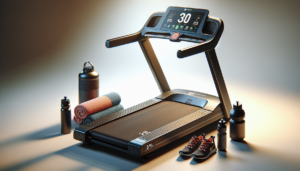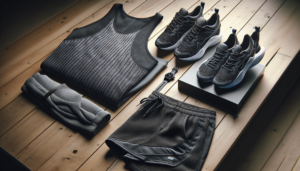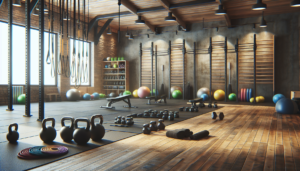Understanding the Triceps Muscle
The triceps muscle plays a crucial role in upper body strength and movement. Located on the back of the upper arm, the triceps is responsible for extending the elbow joint and is involved in various pushing motions. Understanding the anatomy and function of the triceps is essential for developing effective workout routines that target this important muscle group.
Anatomy of the Triceps: Long, Lateral, and Medial Heads
The triceps brachii, commonly known as the triceps, is a large muscle comprised of three distinct heads: the long head, lateral head, and medial head. Each head originates from different points on the humerus and scapula, coming together to insert at the elbow. The long head is the largest of the three and is most involved in overhead extension movements. The lateral head is located on the outside of the arm, while the medial head lies underneath the long and lateral heads.
| Triceps Head | Origin | Function |
|---|---|---|
| Long Head | Infraglenoid tubercle of scapula | Extends elbow, adducts arm |
| Lateral Head | Posterior humerus | Extends elbow |
| Medial Head | Posterior humerus | Extends elbow |
Importance of Training All Three Heads
To achieve optimal triceps development, it’s important to incorporate exercises that target all three heads. While the heads work together to extend the elbow, they are recruited differently depending on the specific movement. For example, overhead extensions emphasize the long head, while pushdowns focus more on the lateral and medial heads.
Including a variety of exercises in your triceps training ensures balanced strength and growth. Neglecting one or more of the heads can lead to muscular imbalances and limit overall triceps development. Aim to include exercises that work the triceps from various angles for the most comprehensive results.
Essential Warm-Up for Triceps Workouts
Before diving into your triceps workout, it’s crucial to properly warm up the muscles to prevent injury and enhance performance. A good warm-up increases blood flow, raises muscle temperature, and prepares the joints for the movements to come. Dedicating just a few minutes to targeted warm-up exercises can make a significant difference in your workout quality and results.
Dynamic Stretches for Arms and Shoulders
Dynamic stretching is an effective way to warm up the triceps and surrounding muscles. Unlike static stretches, which are held for prolonged periods, dynamic stretches involve gentle, controlled movements that gradually increase the range of motion. Some examples of dynamic stretches for the arms and shoulders include:
- Arm circles: Forward and backward
- Shoulder shrugs
- Overhead triceps stretch with pull
- Triceps kickbacks without weight
Perform each stretch for 10-15 repetitions, focusing on smooth, controlled movements. As you progress through the stretches, you should feel your muscles becoming more supple and ready for action.
Benefits of Proper Warm-Up
Taking the time to warm up before your triceps workout offers numerous benefits, including:
1. Reduced risk of injury: Warm muscles and joints are less prone to strains and tears under the stress of exercise.
2. Increased flexibility: Dynamic stretching enhances your range of motion, allowing for fuller and more comfortable movements during your workout.
3. Improved performance: With increased blood flow and muscle temperature, your triceps will be primed to perform at their best, enabling you to lift heavier and with better form.
4. Mental preparation: The warm-up process helps you focus your mind on the workout ahead, establishing a mind-muscle connection that can boost your results.
By making a proper warm-up a consistent part of your routine, you’ll be setting yourself up for safer, more effective triceps workouts.
Top Exercises for Triceps Strength and Definition
Building impressive triceps requires targeted exercises that stimulate all three heads of the muscle. Incorporating a variety of movements that work the triceps from different angles is key to achieving well-rounded development. Here are four of the best exercises for building triceps strength and definition:
Lying Triceps Extension
The lying triceps extension, also known as the skull crusher, is a powerful exercise that targets the long head of the triceps. To perform this movement:
1. Lie on a flat bench with a dumbbell or barbell held above your chest, arms extended.
2. Keeping your upper arms stationary, lower the weight towards your forehead by bending at the elbows.
3. Pause briefly, then extend your arms back to the starting position, engaging your triceps fully.
4. Repeat for the desired number of repetitions.
Maintain control throughout the movement and avoid letting your elbows flare out to the sides. This exercise can be performed with various equipment, such as dumbbells, barbells, or cables, making it a versatile choice for any triceps workout.
Tricep Pushdown
The tricep pushdown is a staple exercise that emphasizes the lateral and medial heads of the triceps. It’s typically performed using a cable machine with a straight or angled bar attachment. Here’s how to do it:
1. Stand facing the cable machine, feet shoulder-width apart, and grasp the bar with an overhand grip.
2. Keeping your upper arms close to your body, push the bar down until your arms are fully extended.
3. Squeeze your triceps at the bottom of the movement, then slowly return to the starting position.
4. Repeat for the desired number of repetitions.
Focus on maintaining tension in your triceps throughout the exercise, avoiding the temptation to use momentum to swing the weight. Experiment with different grip widths and attachments to find what works best for you.
Diamond Push-Up
The diamond push-up is a challenging bodyweight exercise that targets all three heads of the triceps, with an emphasis on the medial head. To perform this movement:
1. Begin in a high plank position with your hands close together under your chest, forming a diamond shape with your index fingers and thumbs.
2. Keeping your body in a straight line, lower your chest towards your hands by bending your elbows back along your sides.
3. Push through your palms to extend your arms and return to the starting position, engaging your triceps throughout the movement.
4. Repeat for the desired number of repetitions.
If diamond push-ups are too challenging, you can modify the exercise by performing them with your knees on the ground or by elevating your hands on a stable surface.
Dumbbell Tricep Kickbacks
Dumbbell tricep kickbacks isolate the triceps, making them an excellent choice for refining definition and addressing muscle imbalances. To perform this exercise:
1. Stand with your feet shoulder-width apart, holding a dumbbell in each hand.
2. Hinge forward at the hips, maintaining a flat back, and bring your upper arms parallel to the floor.
3. Keeping your upper arms stationary, extend your elbows to straighten your arms behind you, squeezing your triceps at the top of the movement.
4. Lower the dumbbells back to the starting position and repeat for the desired number of repetitions.
Avoid using momentum to swing the weights; instead, focus on controlled, deliberate contractions of the triceps. You can perform this exercise one arm at a time or with both arms simultaneously.
By incorporating these four exercises into your triceps training routine, you’ll be targeting the muscle from various angles and with different resistance levels, promoting balanced strength and definition.
Incorporating Triceps Workouts into Your Routine
Now that you have a solid understanding of the triceps muscle and some of the best exercises to target it, it’s time to consider how to effectively incorporate triceps workouts into your overall fitness routine. Consistency and progressive overload are key factors in achieving notable triceps growth and strength.
Progressive Overload for Triceps Growth
Progressive overload is a fundamental principle in resistance training that involves gradually increasing the challenge placed on your muscles over time. By continually pushing your triceps to work harder, you stimulate ongoing adaptations that lead to increased strength and size. Some strategies for applying progressive overload to your triceps workouts include:
1. Increasing weight: As your triceps become stronger, gradually increase the resistance you use in your exercises. This can be done by using heavier dumbbells, barbells, or cable stacks.
2. Increasing volume: Add more sets or repetitions to your triceps exercises over time to challenge your muscles with a higher overall workload.
3. Changing exercises: Periodically incorporate new triceps exercises into your routine to prevent plateaus and continue stimulating growth.
Remember to make small, incremental changes to avoid overloading your muscles too quickly, which can lead to injury or burnout. Aim for a balance between challenging yourself and allowing adequate recovery time.
Balancing Triceps Workouts with Other Exercises
While targeting your triceps specifically is important, it’s equally crucial to maintain a well-rounded fitness routine that includes exercises for other muscle groups. Here are some tips for balancing your triceps workouts with other exercises:
1. Train triceps after larger muscle groups: If you’re performing a full-body or upper-body workout, save your triceps exercises for later in the session, after you’ve completed compound movements like bench presses or shoulder presses.
2. Alternate push and pull exercises: Incorporate pulling movements, such as rows and pull-ups, to balance out your pushing exercises and maintain healthy shoulder joint function.
3. Allow for recovery: Avoid training your triceps on consecutive days, as they need time to recover and grow. Aim for at least one full day of rest between triceps workouts.
4. Prioritize compound movements: While isolation exercises like tricep kickbacks are valuable, compound exercises that engage multiple muscle groups, such as close-grip bench presses and dips, should form the foundation of your triceps training.
By following these guidelines, you can effectively integrate triceps workouts into your fitness routine, promoting balanced strength and overall muscular development.
Common Mistakes and How to Avoid Them
When embarking on a journey to strengthen and sculpt your triceps, it’s essential to be aware of common mistakes that can hinder your progress or even lead to injury. By understanding these pitfalls and implementing proper form and technique, you can maximize your results and maintain a safe, effective triceps training routine.
Incomplete Range of Motion
One of the most prevalent mistakes in triceps training is failing to complete a full range of motion in each exercise. Shortchanging your repetitions by not fully extending or flexing your elbows can limit the effectiveness of the movement and reduce the overall stimulus to the triceps. To avoid this mistake:
1. Focus on controlled, deliberate movements, ensuring that you fully extend your elbows at the top of each repetition.
2. Avoid using excessive weight that compromises your form and range of motion.
3. Maintain mindfulness throughout your sets, concentrating on the sensation of your triceps working through a complete range.
Neglecting Proper Form
Proper form is crucial for targeting the intended muscles and preventing injury during triceps exercises. Common form mistakes include:
1. Flaring the elbows: In exercises like tricep pushdowns and extensions, keep your elbows tucked close to your body to emphasize the triceps and minimize stress on the shoulder joints.
2. Using momentum: Avoid swinging or using momentum to lift the weight, as this reduces the work performed by the triceps and increases the risk of injury. Focus on controlled, deliberate movements.
3. Hunching the shoulders: Keep your shoulders down and back, avoiding shrugging them up towards your ears during triceps exercises.
To ensure proper form, start with lighter weights and focus on mastering the movement pattern before gradually increasing resistance. Consider working with a qualified fitness professional or filming yourself to identify and correct any form issues.
By staying mindful of these common mistakes and actively working to avoid them, you can optimize your triceps workouts for safe, effective results. Remember, quality trumps quantity when it comes to resistance training, so prioritize proper form and technique above all else.
Rest and Recovery for Optimal Triceps Development
While it’s tempting to hit the gym every day in pursuit of your triceps goals, rest and recovery are just as important as the workouts themselves. In fact, it’s during the recovery period that your muscles repair, adapt, and grow stronger. Understanding the role of rest and implementing proper recovery strategies are essential for optimizing your triceps development.
Importance of Rest Days
Rest days are crucial for allowing your triceps (and other muscles) time to recover and rebuild after the stress of exercise. When you work out, you create microscopic tears in your muscle fibers, which your body then repairs and strengthens during the recovery process. Neglecting to take rest days can lead to overtraining, increasing the risk of injury and hindering your progress. Here are some tips for incorporating rest into your triceps training routine:
1. Avoid training triceps on consecutive days, allowing at least one full day of rest between workouts.
2. Listen to your body and take additional rest days if you feel excessive fatigue or soreness.
3. Engage in active recovery activities on rest days, such as light cardio or mobility work, to promote blood flow and relaxation.
Hydration and Nutrition Tips
In addition to rest, proper hydration and nutrition are vital for supporting triceps recovery and growth. Here are some tips to keep in mind:
1. Stay hydrated: Drink plenty of water throughout the day, aiming for at least 0.5-1 ounce of water per pound of body weight.
2. Consume adequate protein: Aim for about 1 gram of protein per pound of body weight to support muscle repair and growth.
3. Eat a balanced diet: Incorporate a variety of nutrient-dense foods, including complex carbohydrates, healthy fats, and colorful fruits and vegetables, to provide your body with the building blocks it needs for recovery.
4. Consider supplements: While a well-rounded diet is the foundation of proper nutrition, supplements like creatine and protein powder can provide additional support for muscle growth and recovery.
| Nutrient | Recommendation |
|---|---|
| Water | 0.5-1 ounce per pound of body weight |
| Protein | ~1 gram per pound of body weight |
| Carbohydrates | Consume complex carbs for energy |
| Healthy Fats | Incorporate sources like avocados, nuts, and olive oil |
By prioritizing rest and recovery, you create an optimal environment for your triceps to grow and strengthen over time. Remember, the work you put in at the gym is only half the equation; the other half is how well you recover and care for your body outside of your workouts.






